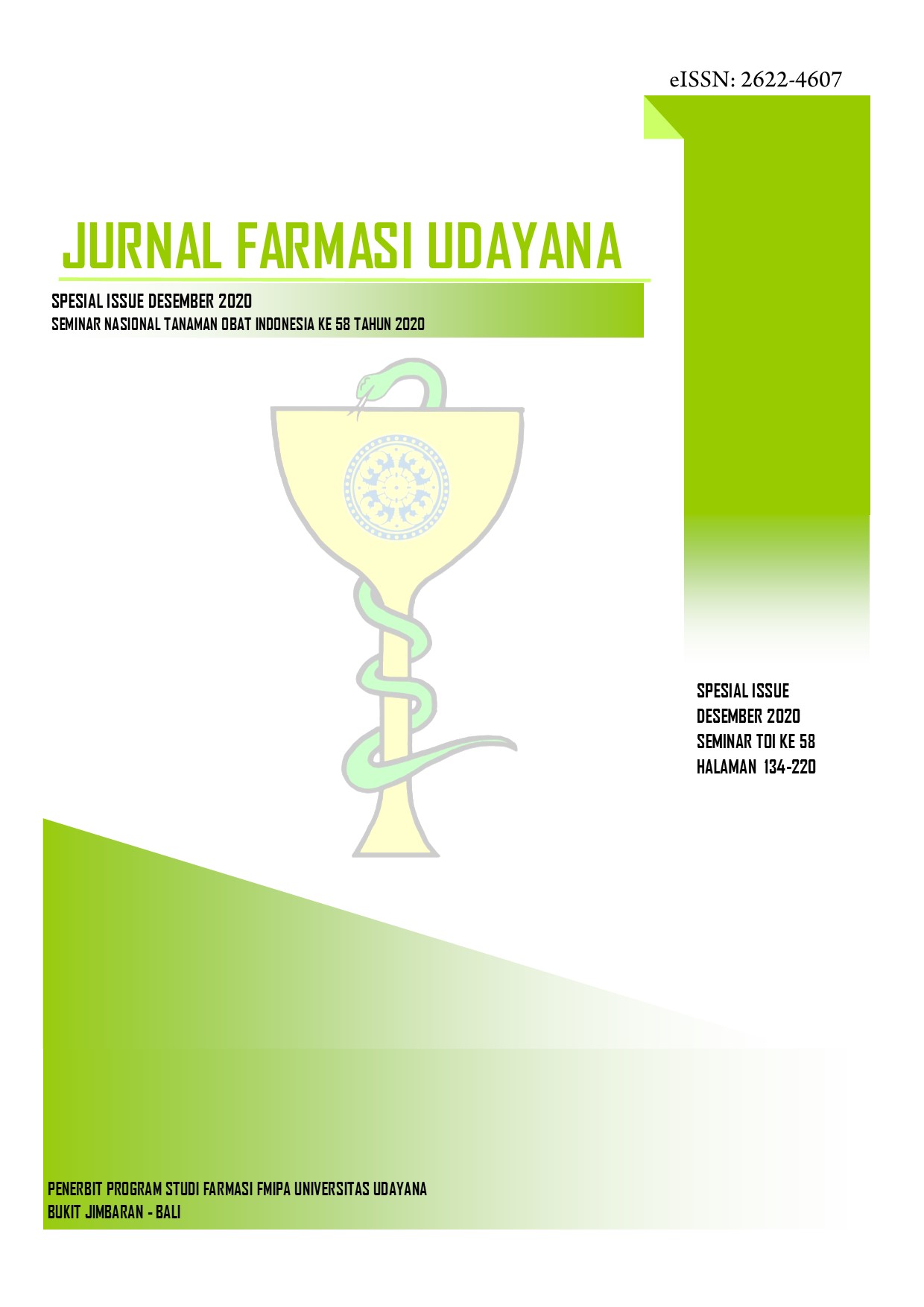Efektivitas Jamu Untuk Perawatan Pasca Stroke Di Rumah Riset Jamu (RRJ) Hortus Medicus Tawangmangu
Abstract
The use of jamu for the treatment of disease has become a method of choice besides conventional treatment using modern medicine, including by stroke survivors. Rumah Riset Jamu (RRJ) Hortus Medicus is a B2P2TOOT’s research house that conducts health service-based research. RRJ Hortus Medicus developed jamu concoctions for post-stroke care containing celery (Apium graveolens L.), gotu kola (Centella asiatica L.), and sembung (Blumea balsamifera L.). This study aims to see the effectiveness of the jamu concoctions. A total of 106 post-stroke patients were recorded having repeated treatment at the RRJ Hortus medicus which was entered from 2013 to 2018. The medical records of these 106 patients were traced and analyzed. The effectiveness parameter assessed was the Neurological Impairment Scale (NIS) score. Jamu concoctions can improve the NIS score average in 58% of patients, which means that jamu concoctions have the potential to be further developed as jamu concoctions for post-stroke care in accordance with BPOM requirements. Jamu was also well tolerated by the research subjects in the absence of any serious side effects after taking jamu concoctions.
Downloads
References
Barker-Collo, S., D.A., B., R.V., K., P., P., V.L., F., M., N., … G.A., R. (2015). Sex Differences in Stroke Incidence, Prevalence, Mortality and Disability-Adjusted Life Years: Results from the Global Burden of Disease Study 2013. Neuroepidemiology, 45(3), 203–214. https://doi.org/10.1159/000441103.Sex
Dianat, M., Veisi, A., Ahangarpour, A., & Fathi Moghaddam, H. (2015). The effect of hydro-alcoholic celery (Apiumgraveolens) leaf extract on cardiovascular parameters and lipid profile in animal model of hypertension induced by fructose. Avicenna Journal of Phytomedicine, 5(3), 203–209. https://doi.org/10.22038/ajp.2015.3839
Farhana, K. M., Malueka, R. G., Wibowo, S., & Gofir, A. (2016). Effectiveness of Gotu Kola Extract 750 mg and 1000 mg Compared with Folic Acid 3 mg in Improving Vascular Cognitive Impairment after Stroke. Evidence-Based Complementary and Alternative Medicine, 2016. https://doi.org/10.1155/2016/2795915
Ghani, L., Mihardja, L. K., & Delima, D. (2016). Faktor Risiko Dominan Penderita Stroke di Indonesia. Buletin Penelitian Kesehatan, 44(1), 49–58. https://doi.org/10.22435/bpk.v44i1.4949.49-58
Han, S.-Y., Hong, Z.-Y., Xie, Y.-H., Zhao, Y., & Xu, X. (2017). Therapeutic effect of Chinese herbal medicines for post stroke recovery A traditional and network meta-analysis. PLoS Medicine, 1–13. https://doi.org/10.1371/journal.pmed1000097
Harini, J. A., Luthra, A., Madeka, S., Shankar, P., Mandava, P., Pervaje, R., … Purushotham, A. (2019). Ayurvedic Treatment of Acute Ischemic Stroke: A Prospective Observational Study. Global Advances in Health and Medicine, 8, 1–8. https://doi.org/10.1177/2164956119849396
Hiraga, A. (2017). Gender Differences and Stroke Outcomes. Neuroepidemiology, 48(1–2), 61–62. https://doi.org/10.1159/000475451
Huang, P.-Y., Hung, Y.-C., & Hu, W.-L. (2016). Complementary therapy with traditional chinese medicine for ischemic stroke. Intech, 241–260. Retrieved from https://www.intechopen.com/books/advanced-biometric-technologies/liveness-detection-in-biometrics
Je, H. D., Kim, H. D., & La, H. O. (2014). The inhibitory effect of apigenin on the agonist-induced regulation of vascular contractility via calcium desensitization-related pathways. Biomolecules and Therapeutics, 22(2), 100–105. https://doi.org/10.4062/biomolther.2014.012
Johnson, C. O., Nguyen, M., Roth, G. A., Nichols, E., Alam, T., Abate, D., … Murray, C. J. L. (2019). Global, regional, and national burden of stroke, 1990–2016: a systematic analysis for the Global Burden of Disease Study 2016. The Lancet Neurology, 18(5), 439–458. https://doi.org/10.1016/S1474-4422(19)30034-1
Johnson, W., Onuma, O., Owolabi, M., & Sachdev, S. (2016). Stroke: A global response is needed. Bulletin of the World Health Organization, 94(9), 634A-635A. https://doi.org/10.2471/BLT.16.181636
Kemenkes, R. I. (2019). Infodatin Stroke Kemenkes RI 2019. Infodatin Stroke Kemenkes RI 2019.
Kemenkes RI. (2018). Laporan Hasil Riset Kesehatan Dasar (Riskesdas) Indonesia tahun 2018. Riset Kesehatan Dasar 2018, pp. 182–183.
Lokanathan, Y., Omar, N., Ahmad Puz, N. N., Saim, A., & Hj Idrus, R. (2016). Recent updates in neuroprotective and neuroregenerative potential of Centella asiatica. Malaysian Journal of Medical Sciences, 23(1), 4–14.
Pang, Y., Zhang, Y., Huang, L., Xu, L., Wang, K., Wang, D., … Xie, X. (2017). Effects and mechanisms of total flavonoids from Blumea balsamifera (L.) DC. on skin wound in rats. International Journal of Molecular Sciences, 18(12), 1–12. https://doi.org/10.3390/ijms18122766
Prokai-Tatrai, K., & Prokai, L. (2018). 17β-estradiol as a neuroprotective agent. IntechOpen, 21–39.
Puttarak, P., Dilokthornsakul, P., Saokaew, S., Dhippayom, T., Kongkaew, C., Sruamsiri, R., … Chaiyakunapruk, N. (2017). Effects of Centella asiatica (L.) Urb. on cognitive function and mood related outcomes: A Systematic Review and Meta-analysis. Scientific Reports, 7(1), 1–12. https://doi.org/10.1038/s41598-017-09823-9
Tashakori-Sabzevar, F., Razavi, B. M., Imenshahidi, M., Daneshmandi, M., Fatehi, H., Sarkarizi, Y. E., & Mohajeri, S. A. (2016). Evaluation of mechanism for antihypertensive and vasorelaxant effects of hexanic and hydroalcoholic extracts of celery seed in normotensive and hypertensive rats. Revista Brasileira de Farmacognosia, 26(5), 619–626. https://doi.org/10.1016/j.bjp.2016.05.012
Turner-Stokes, L., Thu, A., Williams, H., Casey, R., Rose, H., & Siegert, R. J. (2014). The neurological impairment scale: Reliability and validity as a predictor of functional outcome in neurorehabilitation. Disability and Rehabilitation, 36(1), 23–31. https://doi.org/10.3109/09638288.2013.775360
Venketasubramanian, N., Yoon, B. W., Pandian, J., & Navarro, J. C. (2017). Stroke epidemiology in south, east, and south-east asia: A review. Journal of Stroke, 19(3), 286–294. https://doi.org/10.5853/jos.2017.00234
Wang, Y. H., & Zhang, Y. R. (2020). Variations in compositions and antioxidant activities of essential oils from leaves of Luodian Blumea balsamifera from different harvest times in China. PLoS ONE, 15(6), 1–15. https://doi.org/10.1371/journal.pone.0234661
World Heart Federation. (2017). Stroke and hypertension. Retrieved November 3, 2020, from https://www.world-heart-federation.org/resources/stroke-and-hypertension/
Zhang, B., Saatman, K., & Chen, L. (2020). Therapeutic potential of natural compounds from Chinese medicine in acute and subacute phases of ischemic stroke. Neural Regeneration Research, 15(3), 416–424. https://doi.org/10.4103/1673-5374.265545




